Autodesk CEO Aims to Reignite Employee Confidence in AI Amid Workforce Cuts

Autodesk’s CEO, Andrew Anagnost, is doubling down on efforts to restore employee confidence in the company’s AI-led vision, after recent internal reports revealed slipping optimism about artificial intelligence and growing financial unease.
Earlier this year, Autodesk announced a workforce reduction affecting roughly 1,350 employees, or about 9% of its global staff. The layoffs were part of a company-wide reorganisation aimed at reallocating talent and resources toward AI, cloud, platform development, and vertical industry clouds. The move generated internal concerns, as employees sought assurance that the shift would not compromise company culture or job security.
Compounding the uncertainty, findings from an internal survey of design, engineering, construction, manufacturing, and media teams showed a noticeable dip in optimism about AI, coupled with rising anxiety over project budgets and tight margins. The report underscored that while confidence in digital tools remained strong, apprehensions around delivering ROI, upskilling needs, and the company’s future direction were gaining momentum.
In response, Anagnost has intensified communication efforts to clarify the strategic rationale behind the restructuring. He has emphasised that Autodesk’s AI and cloud pursuits are not an abstract ambition but a competitive imperative, positioning the company to better support customers’ evolving workflows and to lead innovation in automation, generative design, and scalable platforms.
Company town halls have been leveraged to share success stories of customer projects where AI tools have increased productivity, reduced errors, and unlocked new value—demonstrating how investments in automation are driving tangible business impact. Anagnost has also met directly with cross-functional teams to listen to frontline concerns about AI adoption, skills development, and the company’s long-term direction.
Autodesk is instituting a series of internal AI training programs, pairing employees with product teams to gain hands-on experience in emerging generative and machine-learning tools. These “AI ambassador” sessions are designed to build grassroots confidence in the technology by allowing employees to experience its benefits firsthand and bring that knowledge back to their day-to-day work.
Anagnost’s message is clear: AI should be viewed neither as a threat nor a buzzword, but as a tool to enhance design intelligence, speed up workflows, and open fresh creative opportunities. He is encouraging teams to think bigger—beyond incremental gains—to imagine how autonomous systems can revolutionise design processes and make Autodesk’s software indispensable to future markets.
Yet, challenges persist. Budget constraints continue to weigh on project plans in certain sectors, while the transition to subscription-based and cloud-delivered tools creates ongoing commercial and adoption hurdles. Autodesk is seeking to address these by tying AI initiatives to measurable outcomes, such as improved time to market, reduced rework, or better sustainability metrics in design.
Analysts and partners say the next few quarters will be pivotal. Success depends not only on AI adoption externally, but on rebuilding internal morale and aligning employees with the mission. Autodesk’s ability to balance technology ambition with cultural resilience may determine its ability to emerge stronger from this transformation phase.
As the company moves forward, the mandate is clear: accelerate with intention. Autodesk’s AI strategy, though bold, must ignite belief among its workforce, customers, and market, that generative intelligence is not just the future of design software, but the future of Autodesk.
















